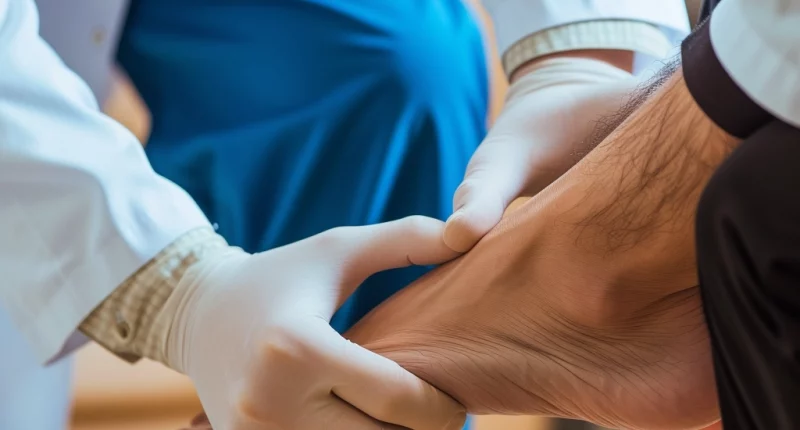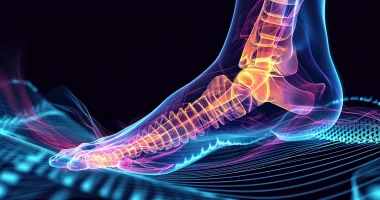Plantar fasciitis
What is a heel spur?
A heel spur ─ is a chronic condition that develops due to microtraumatization of the plantar ligament. The correct name is plantar fasciitis. An osteophyte, an area of bony hypertrophy, forms on the ligament and becomes a source of pain. An osteophyte is a sharp spike over a centimeter long that irritates the surrounding tissues.
Symptoms of a heel spur
Heel spurs do not always manifest themselves from the moment of formation. The severity of pain and discomfort depends on the location of the bony overgrowth. The more superficial the bone spur is located to the nerve endings, the greater the pain.
It all starts with a feeling of a “nail” in the heel. In the first two weeks, such a peculiar pain bothers only at the first steps, and then it calms down on its own. However, painful sensations increase with load and incredibly prolonged walkingovertime.
To avoid pain, the patient tries not to step on the heel. The person’s gait changes, and the body weight is distributed incorrectly. The outer edge of the foot and its forefoot are overloaded, which leads to the formation of transverse flatfoot. The forefoot widens, and an “ossicle” appears at the base of the first toe.
Without treatment, the situation gradually worsens. The pain becomes constant, the foot hurts even at rest. Pain attacks may start and end independently and occur at the most inopportune moment.
Causes of heel spurs
Provoking factors ─ female gender, age over 40 years, permanent residence in the city.
The immediate causes of the disease are as follows:
- congenital flat feet;
- pregnancy, especially multiple pregnancies;
- overweight;
- age-related changes in blood flow and tissue repair rates;
- trauma;
- systemic diseases affecting the nerves, blood vessels, and tissues of the legs ─ diabetes mellitus, gout, rheumatoid arthritis.
In young men and women under 40 years of age, the causes of heel spurs are intense physical exertion and wearing uncomfortable shoes that do not fix the foot ─ flip-flops and shoes with too-high heels.
The plantar fascia is a fibrous ligament that connects the heel bone and the heads of the metatarsal bones. When walking, the ligament is stretched, and the main load is placed on the place of attachment to the heel bone bump. Microtraumas in this place are inevitable, but with moderate load and sufficient rest, they have time to heal.
If the load is excessive, aseptic (without microorganisms) inflammation occurs at the site of the tear. At the site of such inflammation, calcium is gradually deposited, forming a bone spike. The periosteum is irritated, and the spike begins to grow either in the plane of the ligament itself or above it.
A heel spur can form on one foot or both simultaneously, significantly reducing the quality of life.
Plantar fasciitis diagnosis
Heel spurs can be suspected by a characteristic symptom ─ pain when walking. When you feel the heel, you can find the most painful spot. However, an examination is required to make a diagnosis because other diseases can also cause pain in the heel when walking:
- Gout is a disorder of uric acid metabolism;
- Rheumatoid arthritis is a specific autoimmune inflammation of the joints;
- Bechterew’s disease, or ankylosing spondylitis;
- Osteomyelitis – purulent-necrotic inflammation of the bone and surrounding soft tissues;
- Bone tuberculosis;
- Bruise;
- Tendon sprain or ligament damage to the ankle joint;
- Inflammation of a bacterial or viral nature.
The following examinations may be prescribed for differential diagnosis:
- general clinical and biochemical blood tests;
- clinical urinalysis;
- radiographs of the foot;
- MRI of the foot.
If the orthopedist discovers concomitant diseases, then consultations with specialized specialists ─ rheumatologist, infectious disease specialist, traumatologist, therapist, or others, taking into account the clinical situation.
Heel spur treatment
Only a doctor can treat heel spurs since the disease’s characteristics differ for each person. Self-treatment without basic knowledge damages soft tissues, burns, and other troubles.
Treatment is predominantly conservative. Surgical methods are resorted to as a last resort, with a preference for gentle, minimally invasive techniques.
The methods used are:
- medicinal;
- physiotherapy, including shockwave therapy;
- ultrasound exposure;
- laser therapy;
- massage;
Medication treatment is selected by a doctor on an individual basis. Medications are aimed at reducing inflammation and relieving pain. Various medication forms are used: tablets, ointments, plasters.
Quite rarely, on indications, the injection of drugs into the ankle joint cavity or sole is performed. Such manipulation is performed by a surgeon. Painkillers and anti-inflammatory drugs are prescribed in short courses to avoid addiction.
Physiotherapy is the most beneficial. Massage of the lower leg and foot muscles, mud baths and applications, drug electrophoresis, and sonophoresis (administration of drugs without damaging the skin using ultrasound waves) are used. Ultrasound and physical therapy are also used.
Shockwave therapy is widely used when an acoustic wave literally “smashes” calcium deposits. Particles of the deposits are washed out by the bloodstream and eliminated naturally. The procedure simultaneously reduces swelling and inflammation and accelerates tissue regeneration.
With the help of a laser, it accelerates metabolic processes and creates conditions for restoring soft tissues.
Surgical treatment of heel spurs
Scalpel surgeries, when the bone overgrowth is removed together with a section of fascia, are not performed now because such an intervention violates the foot’s anatomy.
Radiofrequency microtenomy is used if indicated, when the damaged fascia with osteophyte is literally “burned out”. The rest of the ligament is not crossed and remains intact. In the field of action, at the same time, it gets a nerve ending, which is also destroyed, and this permanently relieves the person of pain.
The earlier a person seeks medical attention for foot discomfort, the less effort and time it will take to cure.
All these treatment options are available in more than 680 hospitals worldwide (https://doctor.global/results/diseases/plantar-fasciitis). For example, Plantar fasciitis surgery is performed in 45 clinics across Germany for an approximate price of $6.7 K (https://doctor.global/results/europe/germany/all-cities/all-specializations/procedures/plantar-fasciitis-surgery).
Preventive Measures
Preventing plantar fasciitis involves taking steps to avoid putting too much pressure on your feet. Tips for prevention include:
- Wear shoes with good support and cushioning.
- Maintain a healthy weight to reduce pressure on your feet.
- Try low-impact sports like swimming or cycling.
- Stretch your arches, Achilles tendons, and calf muscles regularly.


